
We are celebrating 15 years — and counting — of stories that are deeply researched and deeply felt, that build a historical record of what the city has been.
We are celebrating 15 years — and counting — of stories that are deeply researched and deeply felt, that build a historical record of what the city has been.
Living at land’s edge has always come with a certain amount of risk: storms coming off the ocean can be violent and proximity to water always carries with it a possibility of getting wet. But the vulnerability of coastal living has become clearer in recent years as the tolls of climate change and its attendant specters — sea-level rise and stronger storms — have, quite literally, hit home. The question of how to address this vulnerability boils down to a choice of staying put and protecting communities or reconsidering where and how we settle.
Since Sandy devastated so many coastal areas in 2012, writer Elizabeth Rush has followed the evolution of this debate in a handful of communities in Staten Island. Retreating from the shoreline — and leaving behind homes, memories, and communities — once seemed unimaginable for many residents living in the former wetlands of the island’s eastern shore. And it remains so among many in government; the name of the City’s recovery program — Build It Back — clearly states its position on coastal retreat. But in three communities on Staten Island, a New York State program to encourage managed retreat through homeowner buyouts has elicited strong interest and vocal support. Here, Rush traces the implementation of this complicated strategy and weighs the benefits and costs of what may be an important model for addressing the realities of climate change for our increasingly vulnerable coastal communities.
–J.T.
In Oakwood Beach, Staten Island, an often-overlooked cranny of the city’s “forgotten borough,” the unthinkable is happening — seaside homes of longtime New Yorkers, sold to the State, are being razed to return the neighborhood to wetlands. Walk down Kissam Avenue and the transformation is already evident. Ochre waves of phragmites keel around the 30 or so concrete foundations that remain. On Fox Beach Lane, many homes still stand, their windows boarded over, giving the street the air of a post-apocalyptic movie set.
What once made Oakwood Beach exceptional — the idyllic, seaside setting it offered to residents at an affordable price — is now prompting their departure. While the low-lying neighborhood has long been flood-prone, sea level rise and a higher likelihood of powerful storms making landfall, coupled with increased hardscaping, have exacerbated the problem over the last two decades.
“Our area has been flooding progressively worse year after year: more frequently, more often,” says Frank Moszczynski of the Staten Island Alliance. Nicole Montalto remembers being rescued from her Oakwood Beach home during a Nor’easter in 1992. “My uncle Charley got me out of my house by putting me on top of his shoulders. The saltwater was up to his chest. So no, this isn’t a new problem, but it certainly has gotten worse.” In October 2012, Hurricane Sandy would take her father’s life. He drowned in the basement of the home Montalto’s uncle had rescued her from almost two decades earlier.
When Hurricane Sandy spun into New York Harbor, it awoke the metro area to a stubborn reality that few want to face. With over 520 miles of coastline, considerable portions of which were wetlands just 100 years ago, New York City is among the cities most vulnerable to climate change. This year, the number of New Yorkers living in the 100-year flood plain will rise to well over 400,000. While the party line of “Build It Back” still holds sway in many policy circles and affected communities, a handful of neighborhoods are experimenting with a larger scale solution that most post-Sandy plans scrupulously avoid: retreat.
A Group Decision
Few communities were as hard hit by Sandy as Oakwood Beach, where the storm surge exceeded ten feet, killing three. Three weeks after the storm, residents congregated to review the available assistance. Nearly 100 homes had been destroyed; the rest suffered significant damage. Most were still without electricity or heat.
After two hours of discussing where to obtain food, shelter, health care, and short-term rental assistance, Joseph Tirone, a local real estate broker and former homeowner in Oakwood Beach, posed a question: should residents be offered the pre-storm value of their homes, who would be interested in selling, and leaving? Nearly every one of the 200 residents in attendance raised their hand.
“There was a palpable buzz in the crowd when those hands went up,” Tirone remembers, “because no one expected their neighbors to want to leave.”
Tirone had heard about the federal Department of Housing and Urban Development’s Hazard Mitigation Grant Program (HMGP) a week earlier at a nearby Federal Emergency Management Agency (FEMA) outpost. The HMGP was created in 1988 to reduce the loss of life and property from regularly recurring natural disasters by funding mitigation measures such as resident relocation and flood-proof rebuilding. Only municipalities, not individuals, can apply for its grants to ensure that the en masse actions required for such resilience measures are implementable. Given the lack of care the City had shown the neighborhood in the past, Tirone feared a Hazard Mitigation application would never be filed.
“We have been trying to get the City’s attention for years. Whenever it rains, the street out front fills with water, and that’s just the beginning of it,” recalls John Hojnacki at the local VFW clubhouse. Almost a decade after the 1992 Nor’easter, the City still hadn’t installed the berm it promised would shield the community from regular storm flooding. After the berm went in, Sandy ripped its top right off and yet another torrent of storm water rushed in. Local patience reached its limits. Following the community meeting, a group of long-term residents formed the Oakwood Beach Buyout Committee. They went door-to-door, gauging interest, raising awareness, and mapping the areas where residents no longer felt safe living.
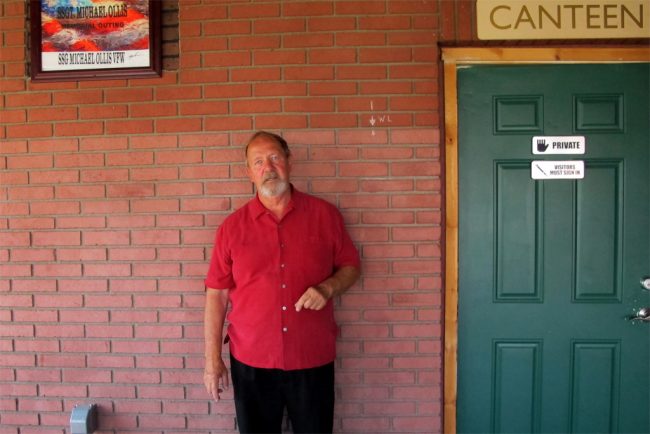
John Hojnacki in front of a wall at the Oakwood Beach VFW clubhouse — the discolored bricks show the water line from Hurricane Sandy.
“This type of community organization is remarkable and profoundly important,” says Liz Koslov, a Ph.D candidate in the Department of Media, Culture, and Communication at New York University studying managed retreat from the coast. “Compare what happened on Staten Island with what happened after Hurricane Katrina, and what became known as the infamous ‘green dot’ map.” Published on the front page of The Times-Picayune, the map showed residential areas that government officials proposed to turn back into open space. Residents were furious, and rightly so: no one consulted them. “This map was perceived as showing how more powerful ‘others’ were trying to dictate where people should and should not live,” Koslov says. In Oakwood Beach, residents illustrated a similar concept of what areas should be relinquished to nature — but making the maps themselves fostered empowerment rather than anger.
“One of the biggest concerns,” Tirone says, “was that the land was going to be redeveloped. Residents didn’t want to see their home bulldozed to make space for luxury condos. When I knocked on their doors and was able to prove to them that the land would go back to nature, those who were holding out became interested.” Many blamed the unprecedented damage during Sandy precisely on increased development in the area and were reluctant to see the process repeat itself.
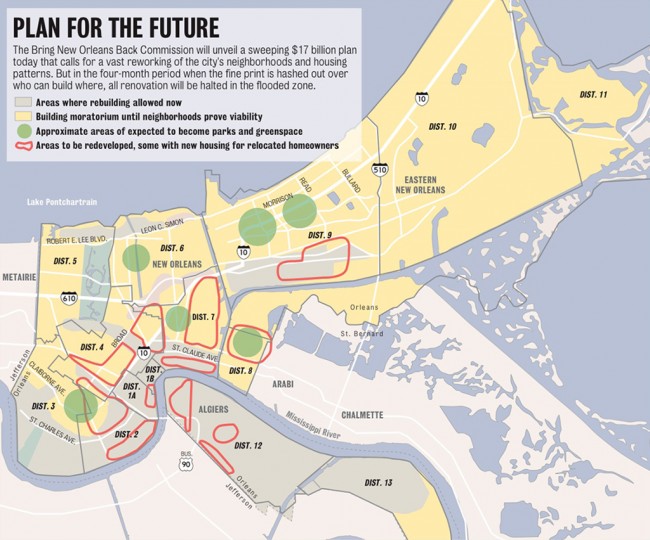
The “green dot” map of New Orleans published in The Times-Picayune following Hurricane Katrina | Image via Karen Apricot
Once the committee had the overwhelming majority of residents interested, they went directly to Governor Cuomo, leapfrogging their municipal representatives who they considered unlikely relocation advocates. Cuomo praised the community and in January 2013 announced a program to leverage federal relief money to purchase Oakwood Beach homes at pre-storm prices.
The buyouts would target low to middle income homeowners, capping payments at roughly $729,500 for single-family homes. Through a creative funding maneuver termed “global match,” federally-administered HUD Disaster Recovery funds would do double duty: by covering the 25% local funding match that the Hazard Mitigation Grant Program requires, the Disaster Recovery funds alleviate the need for municipalities to come up with the match within their own budgets. Covering that match also unlocks additional HMGP funds for mitigation efforts beyond the buyouts, such as elevating homes and buffering infrastructure.
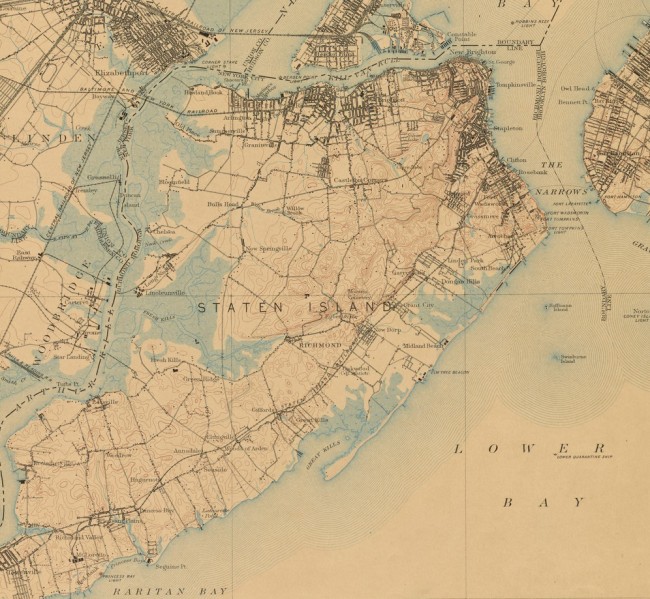
Detail from a 1900 US Geological Survey map of Staten Island showing extensive wetlands | Image via New York Public Library
Once Wetlands, Always Wet
The long history of social organization in Oakwood that helped unify the community around the buyouts arose in response to its markedly precarious location: the neighborhood is sited on former salt marsh on Staten Island’s eastern shore and has long been plagued by recurrent flooding and municipal marginalization.
In 1900, there were over 300 square miles of wetlands within a 25-mile radius of City Hall. Where the land met the sea, egrets nested, muskrats made mischief, white water lilies bloomed. For much of human history, the basic nature of wetlands kept them from being routinely developed. They are, by definition, periodically wet enough to limit use.
But in the 1910s and ‘20s, a significant portion of the metropolitan area’s wetlands – many of which were already used as dumping grounds — were paved over to meet the demands of the city’s growing industrial port. As the shipping industry waned in the ‘40s, the mixed industrial areas were targeted for redevelopment. At the time, living alongside New York’s polluted harbor was considered a nuisance, so public housing and low-middle income housing went in. Places like Breezy Point, Midland Beach, Oakwood Beach, and Red Hook – some of the areas hardest hit by Sandy – were developed as year-round neighborhoods mid-century, providing affordable housing at the city’s less desirable, soggy, and often polluted fringes.
Alan Benimoff, a geology professor at the nearby College of Staten Island, believes that the houses of Oakwood Beach should have never been built. The filling of New York’s wetlands has taken both an ecological and a human toll: more than half of the fatalities from Hurricane Sandy occurred in former wetlands.
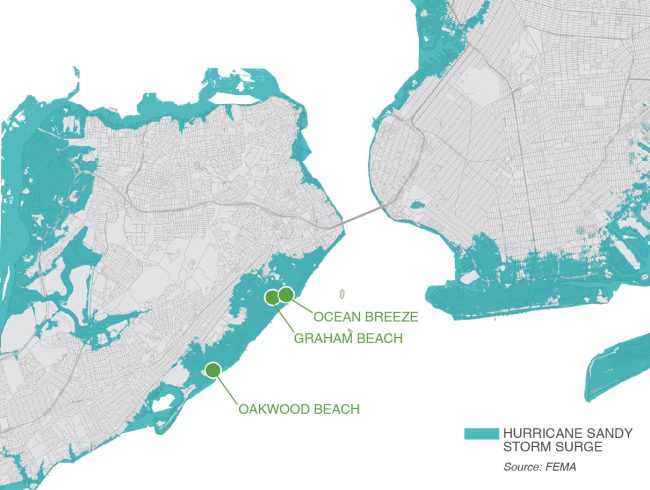
Map of Staten Island communities included in the State-led buyout program with the extent of Sandy’s storm surge | Map by Emily Schmidt
The Domino Effect
Within a year of the storm, some residents of Oakwood Beach were closing on the sale of their homes to New York State and starting anew. Many moved close-by to take advantage of a 5% sale bonus offered by the State to encourage relocation within the five boroughs. All received the additional 10% allotted to residents vacating homes in extremely high-risk zones.
Meanwhile, the City’s glacially slow, poorly managed “Build It Back” program had yet to cut a single check. Seeing their neighbors receive much-needed aid, residents of nearby Graham Beach, Ocean Breeze, Midwood Beach, South Beach, New Dorp Beach, Crescent Beach, Tottenville, and Great Kills organized buyout committees on the model of Oakwood Beach. “We had been trying to work with local politicians for four or five months and it was getting nowhere,” remembers Frank Moszczynski, who lost his Ocean Breeze home during the storm. Moszczynski and other Ocean Breeze leaders set up a tent to distribute information on the buyouts throughout the community. Signs went up urging Cuomo to “buy the Bowl,” a nickname the neighborhood earned from its tendency to fill with rainwater prevented from draining to the Atlantic by Father Capodanno Boulevard, a slightly elevated shore highway. In November 2013 Cuomo agreed to extend the buyout program to Moszczynski’s neighborhood. He would further extend it to include nearby Graham Beach in April 2014.
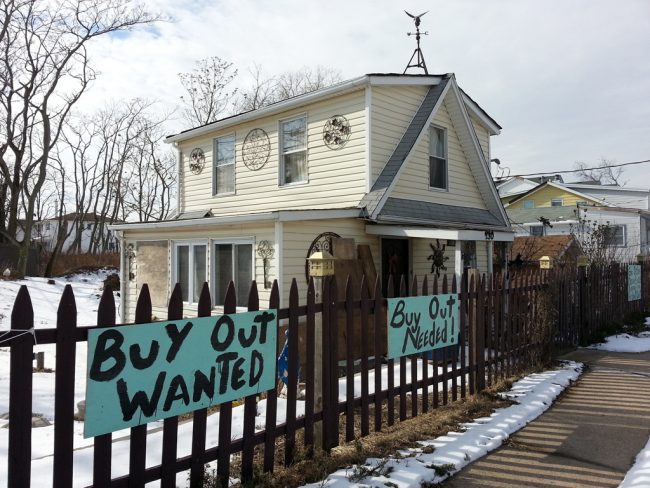
A home in Ocean Breeze advertises for a hoped for buyout | Photo via Matt Green
As the two-year anniversary of Sandy approached, the allure of the buyouts only increased. There were 12,380 Build It Back projects awaiting implementation – 7,800 for repair, 4,000 for elevation, and roughly 500 total rebuilds. On Staten Island, only 138 people had started reconstruction, 38 had started repair, and 400 had received reimbursements as of September 1, 2014. “When you see that number, and it is 5% of the … completed applications, it translates to a lot of desperation,” Moszcynski says.
That desperation, mixed with the empowerment that residents felt as they organized, led to significant buy-in to buyouts. “We were really surprised with what happened after Sandy out on Staten Island,” says Koslov of NYU. “Relocation isn’t just about moving individuals, but also about this question of what happens to collectives. While it is relatively easy to move physical entities, it is much more difficult to move social networks and social support systems. … These are some of the reasons why after terrible destruction – wars or recurrent disasters – the typical response is to build bigger and better.” Rather than viewing buyouts as further evidence of systemic marginalization, many Staten Islanders saw it as a chance to finally move away from the long term neglect that made them vulnerable, offering instead an opportunity for a fresh start.
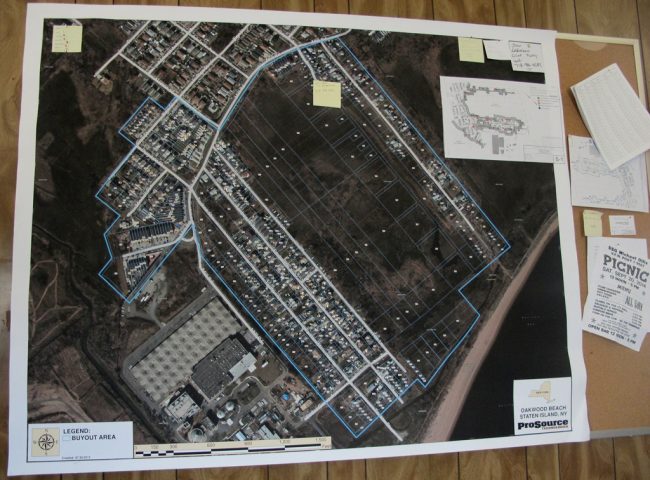
Site maps of the Oakwood Beach buyout area show which properties have been purchased and which utilities have been cut in September 2014.
Washed Out and Left Out
Of the nine buyout committees that sprung up on Staten Island after Sandy, three — Oakwood Beach, Ocean Breeze, and Graham Beach — would successfully organize a State-managed, federal buyout. In April of last year, Barbara Brancaccio, the press representative for the Governor’s Office of Storm Recovery, said that the State had no intention of purchasing the entirety of Staten Island’s eastern shore, limiting the eligible communities to those already selected. The Office of Storm Recovery expects to complete all outstanding home purchases in 2016.
“Part of what made Oakwood Beach, Graham Beach, and Ocean Breeze so attractive and so viable for us was that the residents approached us with an interest rate very close to 100%,” says Rebecca Sinclair, Director of Buyouts and Acquisitions in the Governor’s Office of Storm Recovery. “When you start to purchase and bulldoze homes in a community you have to understand that the housing prices of all the homes in that community that are not part of the buyout will likely drop, so you want to make sure that you have a very high percentage participating.”
In densely populated areas like New York City, even getting 100% of residents in a given community to participate doesn’t safeguard the housing market from adverse effects. John Jaseki, a lifelong UPS employee, says that since the storm and the Oakwood Beach buyout, his ranch-style home directly next to the bought-out area has lost over $100,000 in value. He doesn’t expect it to return any time soon.
“All of us on Mill Road lost so much equity in the homes after Sandy, so we decided to try to get into the buyout program. Naturally I am aggravated we were excluded,” he says, pointing over the sea of marsh grasses toward the recently cleared Kissam Avenue. “I understand they have to be bought out. But they bought two homes on my block, homes that are on higher ground and flooded less, so why did I get left out? Where is the logic there?” According to Jaseki, no one at the Governor’s Office of Storm Recovery returned his calls.
Residents like Jaseki who are not covered by a buyout are still eligible for a different State acquisition program run in conjunction with Build It Back. The program purchases homes at their reduced, post-storm value, and while individual residents are eligible to participate regardless of their neighbors’ interest, acquired properties will be slated for new development rather than turned back to wetland. As of early February, 107 New York City homeowners, the majority of whom live on Staten Island, had expressed interest in this option, and 17 properties are awaiting a purchase offer.
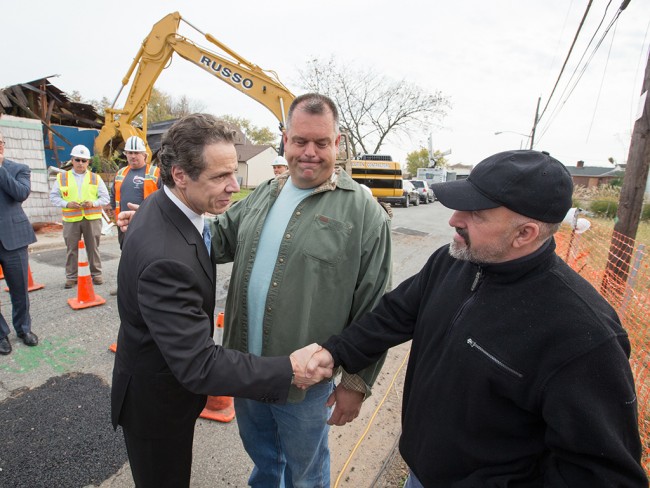
Governor Cuomo visits Oakwood Beach on the second anniversary of Hurricane Sandy in October 2014. | Photo via Governor’s Office of Storm Recovery
A Mixed Bag
When eligibility criteria seem to arbitrarily divvy up neighborhoods, or the processes surrounding them appear opaque or undemocratic, controversy ensues. Too often residents are given mixed messages. When I asked Sinclair how neighborhoods were chosen for buyouts, she cited inundation maps. Brancaccio explained that a lower elevation home that experienced comparable flooding to a bought-out home could be passed over if the surrounding, State-defined neighborhood segment had a lower resident interest rate. Both refused further comment on Jaseki’s case.
Buyouts are complicated: while the money to implement the Staten Island buyouts comes from the federal government, the benefits of getting people out of harm’s way are not cost-free at the municipal level. Not only is it difficult to get a group of people to leave their homes en masse; when they do, it is difficult to require them to stay nearby, which results in a loss of tax revenue. Surrounding communities worry about repercussions on the housing market and the ability to pay civil servants like teachers, firefighters, and police officers. But Laura Tolkoff, Senior Planner for Energy and Environment at the Regional Plan Association, thinks affected communities have little choice: “We need to start to have these conversations because the magnitude of the risks are growing. There are some places in the region where we believe moving away from risk might be the best option in a set of only bad options.”
While loss of tax revenue remains one of the biggest reasons why buyouts have yet to gain traction as a recovery method, the difficulty of relocating low to middle income residents out of the floodplain is another. According to Rising Tides, Rising Costs, a recent study carried out by the Center for NYC Neighborhoods, a disproportionate number of flood zone residents live in small, mortgaged, owner-occupied homes. On Staten Island and elsewhere, these people are largely working class – civil servants, telephone repairmen, educators, social workers, transit operators, police, and firefighters — and they tend to lack the liquidity necessary to rebuild on their own. Relocating within the five boroughs, particularly in the current real estate climate, presents another set of struggles.
The Cost of Rebuilding
For those not offered a chance to participate in a buyout or who voluntarily opted out, the future of coastal living is not nearly as secure or appealing as it once was. Eight of the ten costliest hurricanes to hit the US occurred in the last decade. In the wake of Hurricane Katrina, the federal government spent $120 billon getting New Orleans back on its feet, a Herculean task that is still ongoing. $48 billion was allocated by the federal government for Sandy recovery across all affected areas. While attempting to provide funds for coastal dwellers to rebuild, the National Flood Insurance Program (NFIP) has nearly gone bankrupt, twice. Since 2004, it has borrowed more than $27 billion from the federal government to keep its own head above the rising waters.
In 2012, in a bid to keep the program solvent, Congress passed the bi-partisan Biggert Waters Flood Insurance Reform Act, shifting the financial responsibility for living in a flood zone away from the federal government and toward individual property owners. The act made for some unlikely bedfellows. For its reversal of a longstanding policy of heavily subsidizing flood insurance to promote development, environmentalists celebrated Biggert Waters as the first piece of national legislation to acknowledge the specter of rising sea levels; private insurance companies saw a potential cash cow.
Under the original legislation, homeowners’ premiums could increase by as much as 2,100% in a single year starting in 2013. The average homeowner with a $400 yearly payment would see a rate increase to $9,000 per year. While a 2014 amendment slowed the premium rate increase to 18% per year instead of all at once, the reality remains the same: many low-to-moderate income coastal homeowners — the mainstays of the eastern shore of Staten Island, Coney Island, Red Hook, and the Rockaways — are living on borrowed time.
While most municipal governments in coastal communities— New York City among them — consider “retreat” a four letter word, the buyout participants of Staten Island are making moves that may appear prescient in the coming decades as coastal living becomes too costly and increasingly risky.
Tearing It Down
Once the State purchases a buyout property, a contractor cuts its connections to the electrical grid and sewer and water systems. Demolition usually proceeds quickly, taking about half a day. The contractor will oversee the site for the foreseeable future. Sinclair, directing the project from the Governor’s Office, hopes that by 2016 the Army Corps of Engineers will accept the State’s plan to fully restore the site to wetlands, a process that would include reseeding the land with native grasses and installing retention pools to capture the surge of the next big storm. The goal is to integrate the acquired land into the Staten Island Bluebelt and to hand its stewardship over to the City.
For now the pockmarked roads and other infrastructure remain. As long as Oakwood Beach has residents, the City will keep the lights on.
“When I first saw all of the homes boarded up like that, I thought, ‘My god, what have we done?’” says Patti Snyder, a founding member of the Oakwood Beach Buyout Committee and resident of the neighborhood since age eight. “But it was the right choice. When we found my brother — he died in the basement of the home we grew up in [during Sandy] — I knew that I would never go back. No one should live out there.”
Snyder moved a mile inland and has maintained close ties to her community. But some bought-out Staten Islanders are finding themselves priced out of their borough’s increasingly expensive housing stock or express concern with moving to neighborhoods that have been stereotyped as unsafe. Danielle Mancuso, formerly of Oakwood Beach, moved upstate to Goshen instead, quipping, “There is no ocean in Goshen.” All residents benefitting from the “enhanced buyouts” have relocated to higher ground per the terms of sale.
Not everyone in Oakwood Beach has taken the State’s offer. Gregory Epshteyn, a Russian man who immigrated to the United States during the Cold War, doesn’t believe the State will actually return the land to nature. “Of course they are not going to let this land go undeveloped,” he suggests. “When all of these homes are gone, I will have an even better view and my house will be worth more.” A private developer still holds a large parcel in the middle of the wetlands, complicating the decampment further. “This will be the great battle of managed retreat,” says Sinclair. “People who have wetland property that has some value to the City want that property to be condemned and a price for the property set during a trial.”
“This morning they knocked down the home next to mine, and I slept right through it!” says Loisann Kelly, another hold out who has lived in Oakwood Beach since the 1980s. She brings me to her second story bathroom, which overlooks the demolition site. A widow, Kelly is wary of leaving the memories of her husband that are tied up in the home they shared for most of their marriage. “This is such a confusing time for me,” she says, “I go from never leaving to looking at housing listings online. I know that if my husband were alive he wouldn’t want to leave, but the thing is, I am here alone.”
Of the 326 properties the State plans to purchase in Oakwood Beach, it currently owns 296 and has demolished 60. In Ocean Breeze 52 of the 109 planned purchases have been completed, and acquisitions are just beginning in Graham Beach. And for now Kelly is staying, but she plans to check in with Moss Cape, the case management company handling the buyouts, to better understand the State’s offer. She’s well aware that the chance most likely won’t come again.
Unless otherwise noted, all images by the author.
The views expressed here are those of the authors only and do not reflect the position of The Architectural League of New York.
Comments